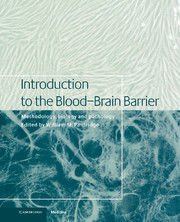Book contents
- Frontmatter
- Contents
- List of contributors
- 1 Blood–brain barrier methodology and biology
- Part I Methodology
- Part II Transport biology
- Part III General aspects of CNS transport
- Part IV Signal transduction/biochemical aspects
- 31 Regulation of brain endothelial cell tight junction permeability
- 32 Chemotherapy and chemosensitization
- 33 Lipid composition of brain microvessels
- 34 Brain microvessel antigens
- 35 Molecular dissection of tight junctions: occludin and ZO-1
- 36 Phosphatidylinositol pathways
- 37 Nitric oxide and endothelin at the blood–brain barrier
- 38 Role of intracellular calcium in regulation of brain endothelial permeability
- 39 Cytokines and the blood-brain barrier
- 40 Blood–brain barrier and monoamines, revisited
- Part V Pathophysiology in disease states
- Index
39 - Cytokines and the blood-brain barrier
from Part IV - Signal transduction/biochemical aspects
Published online by Cambridge University Press: 10 December 2009
- Frontmatter
- Contents
- List of contributors
- 1 Blood–brain barrier methodology and biology
- Part I Methodology
- Part II Transport biology
- Part III General aspects of CNS transport
- Part IV Signal transduction/biochemical aspects
- 31 Regulation of brain endothelial cell tight junction permeability
- 32 Chemotherapy and chemosensitization
- 33 Lipid composition of brain microvessels
- 34 Brain microvessel antigens
- 35 Molecular dissection of tight junctions: occludin and ZO-1
- 36 Phosphatidylinositol pathways
- 37 Nitric oxide and endothelin at the blood–brain barrier
- 38 Role of intracellular calcium in regulation of brain endothelial permeability
- 39 Cytokines and the blood-brain barrier
- 40 Blood–brain barrier and monoamines, revisited
- Part V Pathophysiology in disease states
- Index
Summary
Introduction
The blood-brain barrier (BBB), by virtue of its strategic position, is an important regulatory organ involved in complex communication mechanisms that regulate homeostasis. Soluble biological response modifiers (BRMs), identified as early as 1926, were shown to be capable of mediating this bidirectional regulatory system (Zinssern and Tamiya, 1926). The BBB is not only a constant target of BRMs, but synthesizes its own unique repertoire, which includes eicosanoids, growth factors, chemokines and cytokines. In this chapter discussion is restricted to the classic cytokines and the role of the BBB as both the target and producer of these biologically potent molecules. Cytokines are a heterogeneous group of paracrine and autocrine regulatory glycoproteins. They form a complex network of signals that coordinate diverse pathophysiological events such as BBB development and differentiation (Woodroofe, 1995), response to injury (Beneviste, 1992), and involvement in many acute and chronic neurological diseases (Morgani-Kossmann et al., 1992). The cytokines are capable of inducing long-term responses characterized by phenotypic changes, alteration of cell-cell contacts, and functional reprogramming (Paul and Seder, 1994). A better understanding of cytokine regulatory pathways functioning at the BBB is important to our overall understanding of this complex structure and its role in CNS disease.
- Type
- Chapter
- Information
- Introduction to the Blood-Brain BarrierMethodology, Biology and Pathology, pp. 354 - 361Publisher: Cambridge University PressPrint publication year: 1998
- 1
- Cited by



